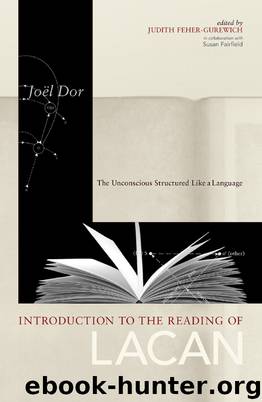Introduction to the Reading of Lacan by Joel Dor

Author:Joel Dor [Dor, Joel]
Language: eng
Format: epub
ISBN: 978-1-59051-661-4
Publisher: Other Press
Published: 2013-03-25T16:00:00+00:00
If the child thus continues, without knowing it, to name the object of his desire by using the Name-of-the-Father as signifier, we can come to only one conclusion: the child no longer knows what he is saying in what he utters. Language therefore appears as that subjective activity in which we say something completely different from what we believe we are saying when we speak. This “something completely different” is installed as the unconscious that escapes the speaking subject because he is constitutively separated from it.
By virtue of this subjective division brought about by the signifying order, language appears as that which is the condition of the unconscious by causing it to come into being and by maintaining it as a locus of selection. Lacan insists upon this point: “Language is the condition for the unconscious.… The unconscious is the logical implication of language: in effect, no unconscious without language” (Lemaire 1977, p. xiii).
To say that the subject is divided is, according to Lacan, to posit that there is no subject other than the speaking being, the parlêtre. It is also to recognize that the causing of the subject is based on the promoting of the unconscious. In other words, the signifying order causes the subject by structuring him in a process of division that founds the unconscious.
These fundamental theses of Lacan’s theoretical work broke radically with contemporary psychoanalytic thought. An example of this is the dispute that arose during the famous Bonneval conference on the unconscious organized by Ey in 1960. On this occasion Jean Laplanche (Laplanche and Leclaire 1966) came to diametrically opposite conclusions by endorsing the thesis that the unconscious is the condition of language. This led to an explanatory intervention on Lacan’s part (Lacan 1960a).
Through this structural division of the subject, primal repression plays an essential role in the advent of the unconscious. We have seen that primal repression bears selectively on the signifier of the mother’s desire (the phallic signifier). It is, of course, a didactic simplification to speak of the phallic signifier. In fact, there are probably several different signifiers that can serve as phallic signifiers, all of them able to designate something of the order of the mother’s desire. Let us call them primordial signifiers. They are signifiers that lend themselves to metaphoric substitution, as a result of which they constitute an unconscious nucleus, the primally repressed.
This primal repression of primordial signifiers must be set in the context of Freud’s (1915c) theory of repression. Here Freud describes repression as a mechanism organized in three phases: primal repression; repression proper or repression after the event; and the return of the repressed in formations of the unconscious. Repression proper is induced by primal repression, which refers to the nucleus of strongly cathected basic representations—in other words, to the primordial signifiers connected with the mother’s desire. Because of this cathexis the original unconscious nucleus is powerfully attractive. This is why Freud describes primal repression as a process of anticathexis, saying that it “represents the permanent expenditure [of energy] of primal repression, and … also guarantees the permanence of that repression.
Download
This site does not store any files on its server. We only index and link to content provided by other sites. Please contact the content providers to delete copyright contents if any and email us, we'll remove relevant links or contents immediately.
Rewire Your Anxious Brain by Catherine M. Pittman(18210)
Talking to Strangers by Malcolm Gladwell(12794)
The Art of Thinking Clearly by Rolf Dobelli(9808)
Mindhunter: Inside the FBI's Elite Serial Crime Unit by John E. Douglas & Mark Olshaker(8644)
Becoming Supernatural by Dr. Joe Dispenza(7788)
Change Your Questions, Change Your Life by Marilee Adams(7317)
The Road Less Traveled by M. Scott Peck(7228)
Nudge - Improving Decisions about Health, Wealth, and Happiness by Thaler Sunstein(7188)
The Lost Art of Listening by Michael P. Nichols(7098)
Mastermind: How to Think Like Sherlock Holmes by Maria Konnikova(6893)
Enlightenment Now: The Case for Reason, Science, Humanism, and Progress by Steven Pinker(6842)
Win Bigly by Scott Adams(6784)
The Way of Zen by Alan W. Watts(6252)
Daring Greatly by Brene Brown(6188)
Big Magic: Creative Living Beyond Fear by Elizabeth Gilbert(5299)
Grit by Angela Duckworth(5261)
Men In Love by Nancy Friday(4929)
Ego Is the Enemy by Ryan Holiday(4885)
Altered Sensations by David Pantalony(4830)
